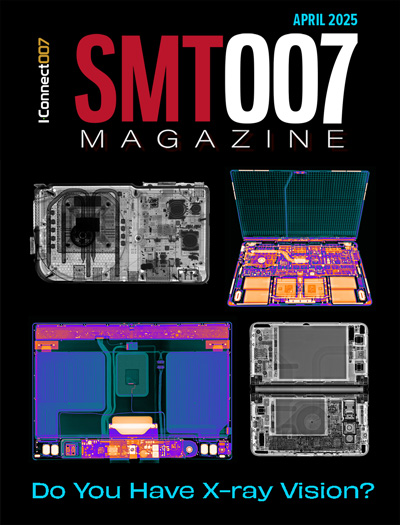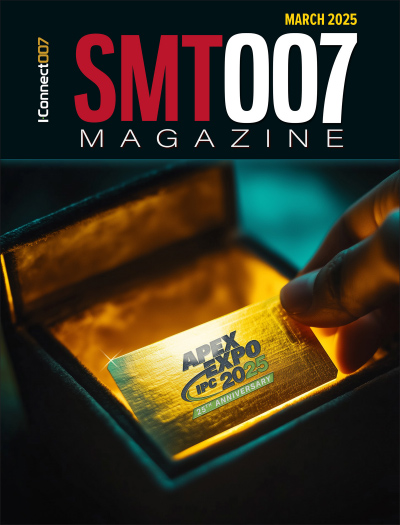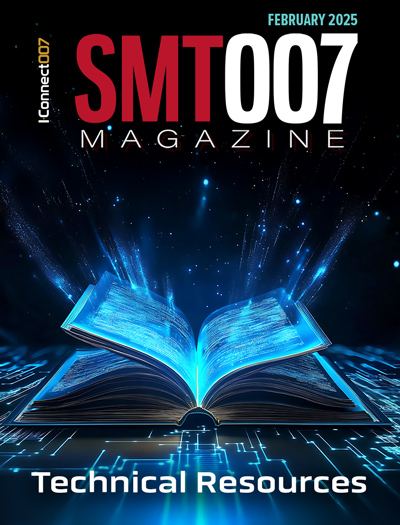-

- News
- Books
Featured Books
- smt007 Magazine
Latest Issues
Current Issue
Do You Have X-ray Vision?
Has X-ray’s time finally come in electronics manufacturing? Join us in this issue of SMT007 Magazine, where we answer this question and others to bring more efficiency to your bottom line.

IPC APEX EXPO 2025: A Preview
It’s that time again. If you’re going to Anaheim for IPC APEX EXPO 2025, we’ll see you there. In the meantime, consider this issue of SMT007 Magazine to be your golden ticket to planning the show.

Technical Resources
Key industry organizations–all with knowledge sharing as a part of their mission–share their technical repositories in this issue of SMT007 Magazine. Where can you find information critical to your work? Odds are, right here.
- Articles
- Columns
Search Console
- Links
- Media kit
||| MENU - smt007 Magazine
IDTechEx Reveal the Future of EVs: Evolution of the Automotive Industry and Electrification Beyond Cars
November 22, 2023 | PRNewswireEstimated reading time: 8 minutes
2023 has proven another momentous year for the electric vehicle (EV) market. 2022 saw electric car sales rise by 62% compared with 2021, and IDTechEx estimates that 2023 will see global sales rise by another 16%. Growth in 2023 was somewhat hampered by the poor performance of plug-in hybrids (PHEVs) in Europe in the first half of 2023, with subsidy phase-outs in Germany. However, even with less aggressive growth than previous years, many will agree that EVs are the future, especially for the passenger car market. So what else can be learned about the future of electrification?
Whilst the electric car has become an everyday term that the general public are now aware of, there are still certainly large technological and market trends occurring in the automotive market. Beyond this, many other vehicle segments are seeing electrification take off; these include various vehicles on the road (vans, trucks, buses, 2-wheelers, 3-wheelers, microcars…), but also off-road segments like construction vehicles and trains.
It isn't just vehicles on land either, with marine sectors (boats & ships, etc.) and aerial vehicles like air taxis (eVTOL) gaining increased interest and market traction. Each vehicle category is at a different stage of electrification and has its own technology and market demands depending on technical feasibility, consumer acceptance, government policy, and several other factors. This article aims to give an update on electrification in several vehicle sectors and what can be expected for the next ten years. IDTechEx is predicting a fairly moderate 2-fold increase in the yearly sales of EVs across all the segments mentioned above by 2034; this is partly due to the sales of electric two- and three-wheelers already stagnating in some major markets. However, the battery demand increases by over 7.7 times in the same period, largely driven by the car market, but with the other segments making a significant contribution.
Technology companies becoming automotive suppliers
Tesla are undoubtedly leaders in the EV space, and it has changed the way that many think about the car as a product. The sales process is more akin to purchasing any other consumer electronics product than what is typically thought of when buying a car. In addition to this, the ownership is taking that form too; many EVs now offer over-the-air updates to keep a car's systems up to date, whereas, for example, many traditional automakers would have had to do this during a service and have been known to require hefty fees to update satellite navigation maps, something that is becoming standard to update for free remotely. Several vehicles now come with features that can be purchased or subscribed to at a later date.
With this transition to cars looking more like a mobile phone than a traditional car, major technology companies have taken an interest in the car market and, rather than supplying small components, are looking at providing the whole car.
Huawei was an early example of this approach and started selling its SERES SF5 in China in 2021. After many years of exhibiting automotive-related technology, Sony has entered a joint partnership with Honda to provide vehicles with production scheduled for 2026. Other examples that have announced projects include Xiaomi, Baidu (a joint venture with Geely), Foxconn, and others. Apple scaled back a fully autonomous car project, but rumors continue on an electric car project.
One of the key issues Tesla had initially was not with the core vehicle technology but the scaling up and quality control of manufacturing cars in large numbers, something that traditional automakers tend to do very well. This will be a big part of why these tech companies have often partnered with traditional automakers or other large manufacturers with experience. This sort of approach could see another key shift in how the automotive market is structured, with traditional OEMs manufacturing the vehicle and tech companies providing the software and integration. The benefit for the end user would be a well-built vehicle that integrates seamlessly with all of their other electronic devices.
Charging infrastructure growth required to meet EV demand
The global EV charging infrastructure market is growing steadily. According to IDTechEx, there were nearly 2.7 million public charging points worldwide in 2022. Nearly 960k chargers were installed globally just in that same year. IDTechEx estimates that 222 million chargers will be needed by 2034 to support the growing global EV fleet. IDTechEx also predicts that the cumulative global investment in global charging infrastructure will exceed US$123 billion by 2034 (hardware cost alone).
There is undoubtedly a huge push to build global public DC fast charging networks. China is leading the race with 1.797 million total public chargers deployed, taking ~70% of the global market share. The US government is providing more than $5 billion in funding and incentives to build a coast-to-coast fast charging network under The National Electric Vehicle Infrastructure (NEVI) Formula Program. The Alternative Fuels Infrastructure Regulation (AFIR) in the EU is similarly driving the growth of public charger installations by mandating a station every 60km along highways. IDTechEx forecasts DC fast chargers to exhibit a higher growth rate in the coming decade, although AC chargers will dominate by unit volume in terms of deployment.
The Global EV charging network remains fragmented, with many chargepoint operators battling for market share across regions. Leading automakers recently adopted Tesla's North American Charging Standard (NACS) charging connector for their US models. Tesla operates the largest global public DC charging network, and in North America NACS outnumbers CCS (combined charging standard) two to one, which explains the switch to Tesla's standard. Furthermore, the network is more reliable and has 20-70% lower deployment costs than their competitors due to in-house design and manufacturing of components. From a technical standpoint, Tesla's connector is lightweight, supports both AC and DC through shared pins, and can support higher amperage due to immersion-cooled cables. IDTechEx's outlook is that cars and EV supply equipment supporting CCS in the US will make up less than 50% market share by the end of the decade, although it will remain the dominant standard across EU+UK regions.
Electric trucks to become a standard goods transport method
The electric truck market in Europe and the US is very much still in its infancy; data from the European Alternative Fuels Observatory (EAFO) suggests there were only 1,607 electric truck registrations in the EU27 countries in 2022, while estimates for the total number of electric medium and heavy-duty trucks on the road in the US is under 3,000 vehicles. However, all of the major OEMs have ongoing electric truck projects, and this work is intensifying, with all manufacturers recognizing the transition to zero-emission powertrains has begun. In 2022 sales of electric heavy trucks in China reached an all-time high, totaling 25,072 units, an increase of 140% on 2021.
Model availability has grown nearly 65% from 2021 until the end of 2022 (from 182 models to 299). Globally, the most robust model-availability growth comes from heavy-duty truck (HDT) models, which reflect 95% growth from 2021 to 2022 (57 models to 111 models) as the technology advances. Medium-duty truck (MDT) models grew 50% year-on-year between 2021 and 2022. Zero-emission heavy-duty trucks have shown preliminary promise in urban freight and short hauling operations under 150 miles per day.
Tesla, Daimler, VW, and Volvo are investing heavily in battery-electric trucks and appear to be winning the total cost of ownership (TCO) battle. Others, such as Toyota, Hyundai, and Nikola, have chosen to focus their efforts on fuel cells (FC). Despite issues with the efficiency of hydrogen as a fuel, FCEVs remain in the conversation as a technology for long-haul trucking applications, where a large range is required. However, current barriers include high upfront vehicle price, high price of hydrogen, and an insufficient hydrogen refueling network.
At least 12 projects targeting commercial EV megawatt (MW) power level charging are now underway or set to begin construction by 2023. These projects were announced in 2021/22, and disclosed investments exceed $1.2 billion. For many projects, the goal is to operate MW-scale chargers to support battery electric truck adoption once the relevant MCS standard is finalized. IDTechEx predicts that MW charging will see quick growth for commercial vehicles but remain a very small part of the overall charging infrastructure market.
eVTOL's to enable air taxi services
A growing number of companies are building full-scale, flying, eVTOL (electric vertical take-off and landing) aircraft. Many eVTOL prototypes have had successful test flights and trials. Still, significant work is necessary, especially on the battery performance, to enhance the practical capabilities of eVTOL aircraft for use in society. A number of eVTOL OEMs have begun work with civil aviation authorities to pursue certification of their commercial eVTOL passenger-grade aircraft. The majority of manufacturers are now testing prototypes and aim to launch commercial services (following successful flight certification) in the 2024-2026 window. Over the years, IDTechEx tracking of eVTOL commercial launch dates shows that they are being pushed back incrementally due to regulatory and not technological hurdles.
Target timelines for eVTOL companies looking to begin commercial production. Source: IDTechEx chart based on 29 company announcements.
IDTechEx research concludes that intracity is not the environment to begin eVTOL air taxi operations as short flights are expensive; there is limited or no time advantage to eVTOL trips less than 40km; a lack of available space for, and price of land for vertiport construction; and the hazard of operating in and above populated cities posing as major barriers. Autonomous flights over longer distances (>50km) will be vital in making air taxi services cost-competitive, and almost all eVTOL OEMs are looking to add this functionality. Not only would eVTOL taxi services be quicker over this range, but they also have the potential to be cheaper than other modes. Yet the journey to build, certify and fly such an aircraft remains expensive, uncertain, and competitive. Industry estimates peg the cost of developing one through to certification at roughly US$1bn.
IDTechEx does not expect the eVTOL air taxi market to start making huge progress within the next ten years but forecasts strong growth later into the following decade as some players complete their certification process.
Many vehicle segments electrifying
IDTechEx's report "Electric Vehicles: Land, Sea & Air 2024-2044" is a comprehensive EV master report covering nine EV markets broken down with over 126 forecast lines. The scope covers all vehicle volume and drivetrain breakdowns, including battery-electric, fuel cell, and hybrid vehicle unit sales, battery demand (GWh), and market revenue generation ($ billion).
Suggested Items
Winners of 2025 IPC Masters Competition China Announced
04/02/2025 | IPCOn March 26-28, the IPC Masters Competition China was successfully held in Pudong, Shanghai. This year’s competition brought nearly 500 electronics industry elites from 18 provinces and municipalities.
Vertical Aerospace Adopts Universal Fast-Charging Standard to Accelerate eVTOL Deployment
04/01/2025 | BUSINESS WIREVertical Aerospace (Vertical), a global aerospace and technology company that is pioneering electric aviation, announces it will adopt the Combined Charging Standard (CCS) for the VX4, joining BETA Technologies and Archer Aviation in driving a universal, fast-charging system for electric vertical take-off and landing (eVTOL) aircraft.
Mazda, ROHM Begin Joint Development of Automotive Components Using Next-Generation Semiconductors
03/28/2025 | ROHMMazda Motor Corporation and ROHM Co., Ltd. have commenced joint development of automotive components using gallium nitride (GaN) power semiconductors, which are expected to be the next-generation semiconductors.
Life in the Fast Lane: A Smooth Ride for Bill Cardoso's New Business Converting Cobra Roadsters to Electric
03/26/2025 | Barry Matties, IPC CommunityBill Cardoso has established quite a list of accomplishments behind his name, from nuclear scientist, organic farmer, and IPC member to entrepreneur and owner of the largest U.S.-based manufacturer in the field of X-ray inspection. Three years ago, though, he brought home a Cobra roadster, and his son’s visceral reaction led to yet another new business venture.
Aismalibar to Showcase Advanced Thermal Management Solutions at APEC 2025
03/13/2025 | AismalibarAismalibar, a global leader in high-performance thermal management materials, is set to exhibit at APEC 2025 (Applied Power Electronics Conference) in Atlanta, Georgia, from March 16–20, 2025. As the premier event for power electronics professionals, APEC provides a crucial platform for industry leaders to explore the latest advancements in thermal interface materials (TIMs), high-performance PCB laminates, and insulated metal substrates (IMS).


